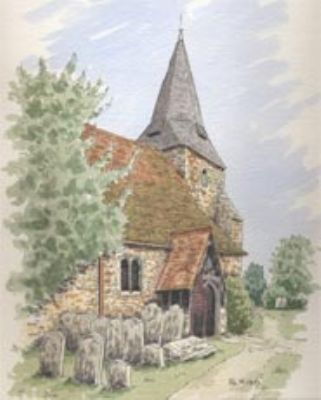The present church at South Bersted dates back to 1405, when it was consecrated and dedicated by the Bishop Reade of Chichester before a large congregation. The church incorporated most of the features of an original church, which had been a focal point of Bersted since the mid thirteenth century, with John Farndon the first named Vicar, in 1254. The village of Bersted itself, known by its Saxon name 'Beorghamsted' (translating to 'Hill village place' in modern English), was part of the Hundred of Pagham given to St Wilfred by Caedwalla all the way back in the 7th century, and transferred by him to the Archbishop of Canterbury, who remains the Church's patron. Bersted acquired Parish Rights in 1200, but it is known that a Saxon chapel dedicated to St Bartholomew was sited in Bersted and possibly connected with a small monastery in North Bersted. No architectural remains have been found, but some stones bearing a Saxon stonemason's mark were discovered and built into the north wall of the chancel over the vestry door.
 With the building of the present church, four large buttresses were added outside to strengthen the old church's tower, and, inside the tower, the outer and larger arch was filled in. Italian-style frescoes were painted on the pillars and you can still see the traces of one of them (depicting St Christopher bearing Jesus over water) on the third pillar in the north aisle. The faint marks of a Mass clock may also just be seen at the east end of the south aisle. It is thought that the chancel was added in the 15th or 16th century, and at some stage internal galleries were built, where congregations would once have sat to worship, looking down on the rest of the church from above.
With the building of the present church, four large buttresses were added outside to strengthen the old church's tower, and, inside the tower, the outer and larger arch was filled in. Italian-style frescoes were painted on the pillars and you can still see the traces of one of them (depicting St Christopher bearing Jesus over water) on the third pillar in the north aisle. The faint marks of a Mass clock may also just be seen at the east end of the south aisle. It is thought that the chancel was added in the 15th or 16th century, and at some stage internal galleries were built, where congregations would once have sat to worship, looking down on the rest of the church from above.
The church has undergone several stages of re-ordering, beginning with a complete re-pewing by Thomas Gray of Shripney in 1729. Since then, the unsightly box pews in which individual families would have sat, closed in by small doors, have been removed, along with the galleries, as part of extensive restoration work between 1879 to 1881. This left the main church structure unchanged, but with new pews and choir stalls, and the old thatched roof, which came down very low and was in a deplorable state, was cleared away and replaced with the present tiled roof. To commemorate this restoration, there is a bust of Archbishop Tait of Canterbury over the north door, and corbels of Queen Victoria a nd Bishop Durnford of Chichester on either side of the chancel arch. Further re-ordering took place in 1986, when four pews were removed at the front of the nave to create extra space for services and, only in 2001, additional pews were removed from the front and back of church to create space now used for coffee and fellowship after services.
nd Bishop Durnford of Chichester on either side of the chancel arch. Further re-ordering took place in 1986, when four pews were removed at the front of the nave to create extra space for services and, only in 2001, additional pews were removed from the front and back of church to create space now used for coffee and fellowship after services.
All the windows are the work of James Powell and Sons of Whitefriars, London - the three-light east window replacing a two-light one and depicting two incidents in the life of Mary Magdalene: her conversion and the appearance of Jesus to her after His Resurrection. A further Powell window was placed at the east end of the south aisle in 1905.
To commemorate the 550th anniversary of the consecration of the consecration of the church, a small clergy vestry was added to the north east corner in 1955. Then, in 1967, a side chapel was created in the north choir aisle, furnished in memory of Arthur Frederick Ashberry, and a window was placed there in 1896 in memory of the Reverend Eric Wells, Vicar for twenty-two years.
For a long time, the church was served by a wooden hall in Gordon Avenue, but this was replaced in 1969 by the present brick halladjoining the churchyard. This was extensively renovated earlier this decade to provide additional facilities and kitchen and office space. It continues to serve several local organisations as well as Church groups and events.
If you would like to add to the Church Micro series yourself then please look here
http://churchmicro.co.uk/
There is also a Church Micro Stats & Information page that can be found at
http://www.15ddv.me.uk/geo/cm/index.html
OR (If your cache page is in html then please copy the text at the bottom of this page instead which has the relevant links included.)
Please can you use this exact format and name it (please don’t add the church name to the title)